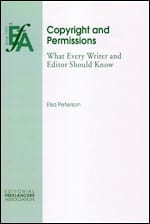 Elsa Peterson has more than 20 years of experience in textbook and academic publishing as a freelance permissions editor, picture researcher, and developmental editor. Her most recent in-house position was as a senior developmental editor for psychology with McGraw-Hill Higher Education. Peterson recently authored a brief and accessible guide to copyright in the context of publishing titled Copyright and Permissions: What Every Writer and Editor Should Know (New York: Editorial Freelancers Association, 2012). She has also authored numerous articles about the business and craft of editing, and has presented TAA audio conferences on editing and copyright.
Elsa Peterson has more than 20 years of experience in textbook and academic publishing as a freelance permissions editor, picture researcher, and developmental editor. Her most recent in-house position was as a senior developmental editor for psychology with McGraw-Hill Higher Education. Peterson recently authored a brief and accessible guide to copyright in the context of publishing titled Copyright and Permissions: What Every Writer and Editor Should Know (New York: Editorial Freelancers Association, 2012). She has also authored numerous articles about the business and craft of editing, and has presented TAA audio conferences on editing and copyright.
Featured Member Karen Timberlake – Textbook project multi-tasking
Karen Timberlake has been writing chemistry textbooks for over 35 years, publishing more than 50 texts including subsequent editions, and…
Featured Member Felicia Moore Mensah – Learn as you mentor
Felicia Moore Mensah, Ph.D. is an Associate Professor of Science Education at Teachers College, Columbia University. She is widely published…
Journal impact factors: To cite, or not to cite?
At a brainstorming session on academic publishing at TAA’s June 2012 conference, a participant asked how to determine the most prestigious journals in which to try to publish. The panel’s advice: study the journal impact factors.
An impact factor is widely regarded as a measure of the journal’s importance in the particular disciplines which it serves. A journal’s impact factor is a measure of the average frequency with which articles in a given journal’s publication year are cited in that and other journals during the subsequent two years. The rationale is, roughly, that the citation rate of articles in a given journal, compared with the rate of “competing” journals, gives a metrical measure of that journal’s perceived importance in the discipline. Seems simple enough, but perhaps not.
Think of yourself as a writer
Authors need to understand the process by which their manuscript will be evaluated and take that into account when they submit. If a smart recent college graduate can’t decode what your book is about, you’re in trouble.
When I graduated from college I hoped to land a job working on a dude ranch in Wyoming. Instead, I fell into a career in scholarly publishing, acquiring books for Oxford University Presses. I realize now that as an editor I didn’t pay nearly enough attention to the prose. I cared more about the ideas than about how well they were expressed, at least that’s what I told myself. It wasn’t true.
Stretch, reach and fall back: Targeting your submission to the journal
Deciding where to submit your journal article can be a daunting task. Not all journals are created equal. Journals differ in content and, of course, in the more elusive, status within the discipline. What I will write about here is how to select and refine your submission based on the journal’s status within your discipline. Two strategies can smooth out the submission process. The first strategy illustrates one way to decide on the journal in which you want to publish. The second strategy is how to analyze the articles within that selected journal to focus your writing to that audience.





